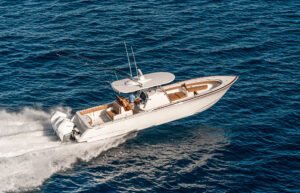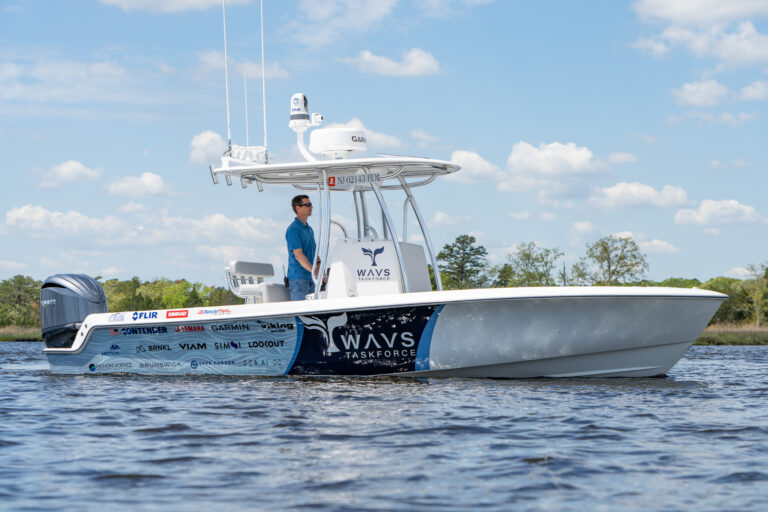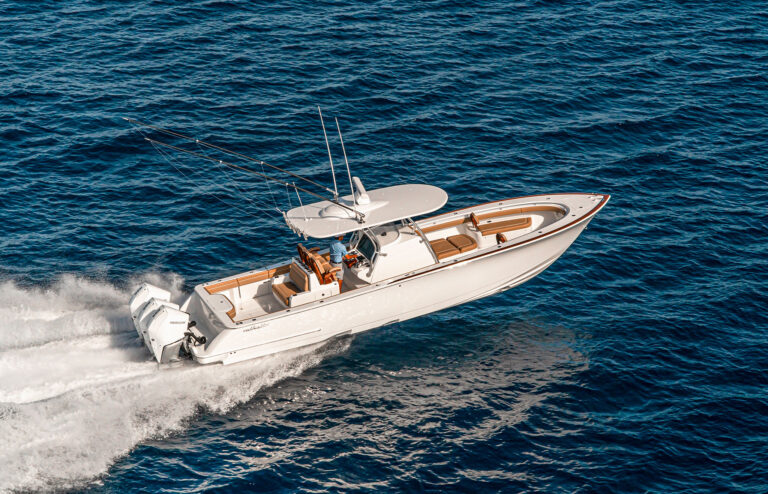I ‘m a big fan of the quirky, minimalist look of a Huckins yacht. It’s a seagoing version of the Saab 900, the result of a no-nonsense and function-driven, though classically informed, philosophy. I like the way these boats stand out from everything else.

I followed closely the rebuilding of a double-planked mahogany-and-white-oak-framed 45-foot 1954 model that was repowered with Volvo Penta IPS pods a few years ago by Yachting Solutions in Rockland, Maine. The boat was given a new wood bottom, including a laminated white oak keel and keelson, which was then sheathed in fiberglass for added strength to stand up to projected IPS grounding loads.
Painted haze-gray from mast to boot top, she’s a beauty to behold. Big windows flood the interior with sunlight, making the saloon and master stateroom happy places to frequent. And the hull is a lot more prominent than the deckhouse, as a well-proportioned boat should be. It made a real impression on me — its unpretentiousness and charm masked what is, for me, an innate superiority over most modern designs.
One of Huckins’ latest projects is a 45 Sportfisherman, and although it has a larger deckhouse, it’s sensibly proportioned by today’s standards, which helps with seakeeping and comfort in a seaway.
The 45 Sportfisherman is a hard-core boat — if one can say that of such a nicely appointed yacht — intended by its owner for fishing off South Florida and in the Bahamas, according to Huckins president Cindy Purcell, the granddaughter of founder Frank Huckins. It follows reliably in its predecessors’ wake in terms of looks and proportions. The trunk cabin creates plenty of headroom forward, and the saloon in the middle of the boat, with its big windows, provides a great seated view, as well as inviting in a lot of sunlight.
It’s also raised in elevation off the keel, providing room for the fuel tank below the aft half. Being forward, near the hull’s center of flotation, is a good place for the variable weight of the fuel because hull trim changes little as fuel state varies. Ideally, the center of gravity of the fuel is slightly forward of the boat’s CG, so the bow comes up, rather than the stern, as the boat lightens up and speed increases.
The sheer on this boat is slightly upswept all the way to the bow, and here the boat is different — and I think a little better-looking — than its boxier, straight-sheer predecessors. The stem also has both rake and curvature, in consonance with its more shapely sheer. The exterior look is more modern, though with the builder’s original proportions and deckhouse fundamentals remaining. There’s a teak cap rail along the bow and side decks, and teak covering boards in the cockpit, but that, and the swim platform, are the only wood topside. Purcell says the boat is scheduled for completion this summer.
Huckins contracts out its hulls and decks and finishes them off at its Jacksonville, Fla., yard. And you’d be hard-pressed to find a more competent builder for the Huckins 45’s hull and deck than Duer High Performance Composites in Beaufort, S.C., a company with aerospace and military experience. A Florida tooling company provided the male mold to which Duer fastened Core-Cell foam with fiberglass laminates.
The part — now an outer skin and core — was then covered with a plastic bag, sealed and infused under vacuum with AME 6001, a vinylester resin with very good strength and osmosis- and impact-resistance properties. Next, this part was reinforced so it would hold its shape, popped off the mold, flipped over and the inner fiberglass skin applied.
Foam densities in the hull and deck were selected based on the anticipated loads in various areas, and the highest-density foam was applied where there would be high point and compression loads, such as through-hull fittings and cleats. After the parts are longboarded (faired by sanding on a macro scale to remove surface hills and valleys), the hull and deck were shipped to Huckins for outfitting and finishing off.
Duer will travel to Huckins to complete the structure by aligning and bonding the hull-to-deck joint. Huckins also will complete the hull and deck fairing and sanding, and paint the parts so the boat will look as if it came out of a production female mold.
Bill Prince Yacht Design, of Port Washington, Wis., did the design and detailed engineering work for this project using the stock Huckins hull as a baseline. Although the boat is in the early stages of construction, I feel as if I’ve already been aboard, having gone through Prince’s life-like CAD renderings of the boat’s interior and exterior. In addition to being effective in showing off the designer’s skill with CAD programs, these renderings are valuable for the perspective and 3-D insight they provide to the owner, builder and designer as to how the finished project will work in real life before the first drum of resin is uncorked.

They also help create a higher-quality boat. For example, Prince provided full-scale Mylar templates that Duer used to cut the interlocking stringers and bulkheads, then fit them together and to the hull’s inner skin. Duer reported that everything fit together perfectly, as good as Lego blocks, the first time. I think these fellows are apt to work together on another project someday.
Cockpit

This boat is designed to fish, and the owner specified a large cockpit sufficiently low to the water to bring fish aboard but not at the expense of reserve buoyancy aft — a key element of seaworthiness. There’s a live well on centerline at the transom, storage boxes under the gunwales with toe kick for better balance and big scuppers through the transom in the aft corners for quick deck drainage and easier cleanup.
There are receptacles for electric reels, twin top-loading freezers for bait on one side and frozen food on the other, a tackle drawer and a bait station. There’s even an Eskimo ice machine that feeds directly into one of the two coolers forward, which double as handy mezzanine-like aft-facing seats — perfect for keeping an eye on the lines. This boat is not meant to be fished forward, at least not regularly, so the side decks are wide enough for easy and safe passage but not so wide that they rob space from the interior.
Engine room
The engine room is accessed by lifting the cockpit stairs to the bridge deck and walking down another set of stairs, making for comfortable access. Once you’re down there, you’ll find 60 inches of headroom, good for a 45-footer. That’s important because an uncomfortable mechanic or owner is more likely to be in a hurry, and machinery condition and reliability are more apt to suffer.
Bridge deck
The bridge deck is up four big stairs from the cockpit, so you don’t have to climb a ladder to get around on this boat, unless you want to run the boat or spot fish from the half tower. This makes it easy for the skipper to get from the wheel to the rods, with just enough height of eye above the waterline for a reasonable distance to the horizon and good all-around sightlines.
In the 1950s and ’60s, this low-bridge-behind-the-deckhouse layout was popular on Chris-Craft cruisers, and for good reason, because it allowed a relatively low profile combined with an outside helm station that could be protected by either a hard or soft enclosure.
The air-conditioned bridge deck has a small dinette to port with more storage below, and the raised helm is to starboard. It looks as if the skipper will have a clear view of the cockpit while being close enough to communicate without shouting, assuming the engine mufflers are effective. The forward-sloping windshield is tinted to reduce eye strain and deflect air and spray upward, and it serves as the attachment point for the plastic curtains that keep the spray out and the A/C in.
This open bridge with soft enclosure provides the benefits of both worlds — you can choose being outside in the fresh sea breeze or inside in climate-controlled surroundings. In addition to its accessibility from cockpit and cabin, the moderate height makes this bridge more comfortable, particularly when rolling in a seaway, than a conventional convertible, with the passengers closer to the boat’s neutral roll axis. Gentler motions make it a safer place to be, as well, an attribute complemented by plenty of hand-holds.
The half-tower is outfitted with full controls so you can run the boat from up high, as needed. A half-tower typically uses the bridge hardtop as its platform, and the resulting height is perfect for many owners — high enough to see fish but not so high that you get jerked around by the boat’s rocking motions. Fishing or not, the tower is also a great place to be when the weather is nice, both because of the view and because the distance from the machinery keeps it so quiet. (The wind makes more noise than the engines do up here.) It’s also easy to climb the tower from the bridge or the cockpit, with the legs mounted to the gunwale forward in the cockpit so you can just step across the storage box lids when coming down from the helm.
Saloon and cabin
From the bridge, it’s four steps down to the saloon with those big side windows. Unfortunately, from my point of view, the windshield fitted in the original boats is gone, with cabinetry forward filling in the volume that would have provided a clear view forward. The lack of a windshield also eliminates the possibility of a lower helm station, but given the comfort and protection the bridge affords on this boat, that’s not much of an issue.
The saloon is comfortably and conventionally laid out, with a settee to port and the galley opposite. The galley stretches the length of the saloon, so it’s a bit of a hike from the sink forward to the range aft, with a refrigerator-freezer in between.
There appears to be less galley storage than you would find on today’s floating cottage, with those big side windows spanning the whole counter, but I’d much rather have the view than feel as if I’m in a cave.
These are all personal tastes, and I’m sure this arrangement reflects what the owner wants, and perhaps what I would have chosen. Ergonomically, a more compact galley would work better, but I might like this one just fine if I lived with it for a while.
Forward and one step down from the saloon is the cabin, which sleeps four. A guest stateroom is to port, with upper and lower berths and a head opposite to starboard. The owner’s stateroom, with a queen berth, is forward.
Propulsion
This Huckins customer opted for Cummins 6BTA 460 diesels and ZF pod drives. Pods deliver more speed for the horsepower and better efficiency for boats that cruise in the 25-plus-knot range. The counter-rotating props take the twist out of the discharge and convert more energy to forward thrust. The lower units also create less drag than a conventional inboard’s shafts, struts, props and rudders, and this difference in resistance really starts to matter above the 25-knot range.
Conclusion
There’s a lot to like about this Huckins. I’d modernize future hulls by adding deadrise forward so the owner will be able to more comfortably run offshore at the higher speeds that lightweight, compact diesels make possible. The conditions in which the owner will be able to take advantage of the pod drives’ 25-plus-knot efficiency advantages will be more limited than they could be otherwise. Well-designed conventional shafts can be just as efficient as pods at lower speeds, especially in the semiplaning region.
I like the boat’s layout. Its functionality reminds me of a pilothouse motoryacht, which is one of the most practical cruising designs around because the bridge is convenient to the cabin, upper bridge and saloon. I am happier inside a boat when I can see out and when sunlight can stream in, so this one gets a check mark here, as well.
I like the bridge deck design for all of the advantages mentioned — accessibility, a favorable height of eye, and sightlines that create better situational awareness and, therefore, make the boat safer to be aboard. The Huckins is exceptionally well built, and the use of foam coring and resin infusion has the potential to reduce displacement by several thousand pounds, adding a knot or two for a given thrust and fuel consumption. Coring also adds thermal and acoustic insulation for reduced A/C loads and a quieter ride.
Cruising through the Newport, R.I., harbor last summer with my family, we saw three or four vintage Huckins, and each was a head-turner. Talk to Cindy Purcell and tell her you’d like your next boat to get just as much attention, while earning yourself a little respect for good judgment in the process.
See related articles:
– The legendary Huckins PT boats
March 2014 issue










